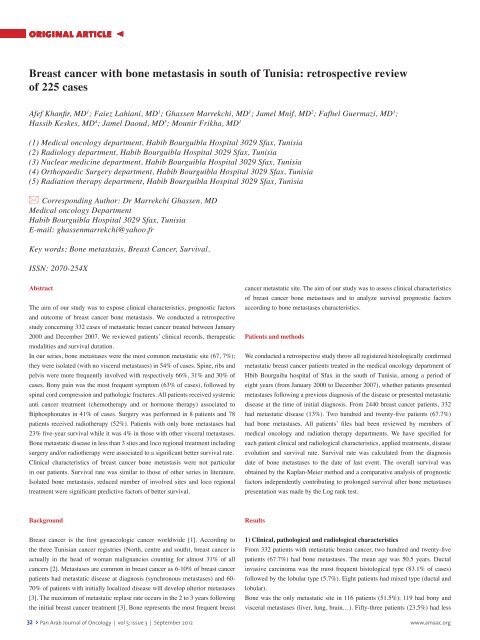Pan Arab Journal of Oncology - Arab Medical Association Against ...
Pan Arab Journal of Oncology - Arab Medical Association Against ...
Pan Arab Journal of Oncology - Arab Medical Association Against ...
Create successful ePaper yourself
Turn your PDF publications into a flip-book with our unique Google optimized e-Paper software.
original article <<br />
Breast cancer with bone metastasis in south <strong>of</strong> Tunisia: retrospective review<br />
<strong>of</strong> 225 cases<br />
Afef Khanfir, MD 1 ; Faiez Lahiani, MD 1 ; Ghassen Marrekchi, MD 1 ; Jamel Mnif, MD 2 ; Fafhel Guermazi, MD 3 ;<br />
Hassib Keskes, MD 4 ; Jamel Daoud, MD 5 ; Mounir Frikha, MD 1<br />
(1) <strong>Medical</strong> oncology department, Habib Bourguibla Hospital 3029 Sfax, Tunisia<br />
(2) Radiology department, Habib Bourguibla Hospital 3029 Sfax, Tunisia<br />
(3) Nuclear medicine department, Habib Bourguibla Hospital 3029 Sfax, Tunisia<br />
(4) Orthopaedic Surgery department, Habib Bourguibla Hospital 3029 Sfax, Tunisia<br />
(5) Radiation therapy department, Habib Bourguibla Hospital 3029 Sfax, Tunisia<br />
Corresponding Author: Dr Marrekchi Ghassen, MD<br />
<strong>Medical</strong> oncology Department<br />
Habib Bourguibla Hospital 3029 Sfax, Tunisia<br />
E-mail: ghassenmarrekchi@yahoo.fr<br />
Key words: Bone metastasis, Breast Cancer, Survival.<br />
ISSN: 2070-254X<br />
Abstract<br />
The aim <strong>of</strong> our study was to expose clinical characteristics, prognostic factors<br />
and outcome <strong>of</strong> breast cancer bone metastasis. We conducted a retrospective<br />
study concerning 332 cases <strong>of</strong> metastatic breast cancer treated between January<br />
2000 and December 2007. We reviewed patients’ clinical records, therapeutic<br />
modalities and survival duration.<br />
In our series, bone metastases were the most common metastatic site (67, 7%);<br />
they were isolated (with no visceral metastases) in 54% <strong>of</strong> cases. Spine, ribs and<br />
pelvis were more frequently involved with respectively 66%, 31% and 30% <strong>of</strong><br />
cases. Bony pain was the most frequent symptom (63% <strong>of</strong> cases), followed by<br />
spinal cord compression and pathologic fractures. All patients received systemic<br />
anti cancer treatment (chemotherapy and or hormone therapy) associated to<br />
Biphosphonates in 41% <strong>of</strong> cases. Surgery was performed in 8 patients and 78<br />
patients received radiotherapy (52%). Patients with only bone metastases had<br />
23% five-year survival while it was 4% in those with other visceral metastases.<br />
Bone metastatic disease in less than 3 sites and loco regional treatment including<br />
surgery and/or radiotherapy were associated to a significant better survival rate.<br />
Clinical characteristics <strong>of</strong> breast cancer bone metastasis were not particular<br />
in our patients. Survival rate was similar to those <strong>of</strong> other series in literature.<br />
Isolated bone metastasis, reduced number <strong>of</strong> involved sites and loco regional<br />
treatment were significant predictive factors <strong>of</strong> better survival.<br />
cancer metastatic site. The aim <strong>of</strong> our study was to assess clinical characteristics<br />
<strong>of</strong> breast cancer bone metastases and to analyze survival prognostic factors<br />
according to bone metastases characteristics.<br />
Patients and methods<br />
We conducted a retrospective study throw all registered histologically confirmed<br />
metastatic breast cancer patients treated in the medical oncology department <strong>of</strong><br />
Hbib Bourguiba hospital <strong>of</strong> Sfax in the south <strong>of</strong> Tunisia, among a period <strong>of</strong><br />
eight years (from January 2000 to December 2007), whether patients presented<br />
metastases following a previous diagnosis <strong>of</strong> the disease or presented metastatic<br />
disease at the time <strong>of</strong> initial diagnosis. From 2440 breast cancer patients, 332<br />
had metastatic disease (13%). Two hundred and twenty-five patients (67.7%)<br />
had bone metastases. All patients’ files had been reviewed by members <strong>of</strong><br />
medical oncology and radiation therapy departments. We have specified for<br />
each patient clinical and radiological characteristics, applied treatments, disease<br />
evolution and survival rate. Survival rate was calculated from the diagnosis<br />
date <strong>of</strong> bone metastases to the date <strong>of</strong> last event. The overall survival was<br />
obtained by the Kaplan-Meier method and a comparative analysis <strong>of</strong> prognostic<br />
factors independently contributing to prolonged survival after bone metastases<br />
presentation was made by the Log rank test.<br />
Background<br />
Results<br />
Breast cancer is the first gynaecologic cancer worldwide [1]. According to<br />
the three Tunisian cancer registries (North, centre and south), breast cancer is<br />
actually in the head <strong>of</strong> woman malignancies counting for almost 31% <strong>of</strong> all<br />
cancers [2]. Metastases are common in breast cancer as 6-10% <strong>of</strong> breast cancer<br />
patients had metastatic disease at diagnosis (synchronous metastases) and 60-<br />
70% <strong>of</strong> patients with initially localized disease will develop ulterior metastases<br />
[3]. The maximum <strong>of</strong> metastatic replase rate occurs in the 2 to 3 years following<br />
the initial breast cancer treatment [3]. Bone represents the most frequent breast<br />
32 > <strong>Pan</strong> <strong>Arab</strong> <strong>Journal</strong> <strong>of</strong> <strong>Oncology</strong> | vol 5; issue 3 | September 2012<br />
1) Clinical, pathological and radiological characteristics<br />
From 332 patients with metastatic breast cancer, two hundred and twenty-five<br />
patients (67.7%) had bone metastases. The mean age was 50.5 years. Ductal<br />
invasive carcinoma was the most frequent histological type (83.1% <strong>of</strong> cases)<br />
followed by the lobular type (5.7%). Eight patients had mixed type (ductal and<br />
lobular).<br />
Bone was the only metastatic site in 116 patients (51.5%); 119 had bony and<br />
visceral metastases (liver, lung, brain…). Fifty-three patients (23.5%) had less<br />
www.amaac.org









